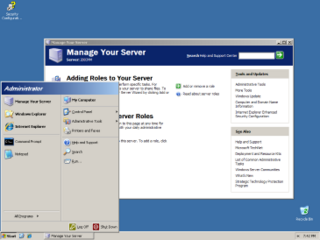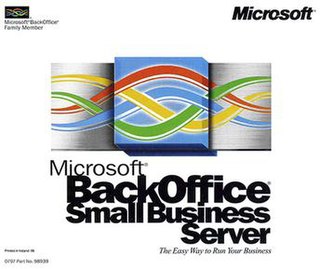Microsoft Windows is a proprietary graphical operating system developed and marketed by Microsoft. It is a line of products grouped into families and sub-families that to some extent cater to a certain sector of the computing industry -- Windows (unqualified) for a consumer or corporate workstation, Windows Server for a server and Windows IoT for an embedded system. Defunct families include Windows 9x, Windows Mobile, Windows Phone, and Windows Embedded Compact.

Microsoft Office, or simply Office, is a family of client software, server software, and services developed by Microsoft. It was first announced by Bill Gates on August 1, 1988, at COMDEX in Las Vegas. Initially a marketing term for an office suite, the first version of Office contained Microsoft Word, Microsoft Excel, and Microsoft PowerPoint. Over the years, Office applications have grown substantially closer with shared features such as a common spell checker, Object Linking and Embedding data integration and Visual Basic for Applications scripting language. Microsoft also positions Office as a development platform for line-of-business software under the Office Business Applications brand.

Windows 2000 is a major release of the Windows NT operating system developed by Microsoft and designed for businesses. It was the direct successor to Windows NT 4.0, and was released to manufacturing on December 15, 1999, and was officially released to retail on February 17, 2000 and September 26, 2000 for Windows 2000 Datacenter Server. It was Microsoft's business operating system until the introduction of Windows XP Professional in 2001.

Microsoft FrontPage is a discontinued WYSIWYG HTML editor and website administration tool from Microsoft for the Microsoft Windows line of operating systems. It was branded as part of the Microsoft Office suite from 1997 to 2003. Microsoft FrontPage has since been replaced by Microsoft Expression Web and SharePoint Designer, which were first released in December 2006 alongside Microsoft Office 2007, but these two products were also discontinued in favor of a web-based version of SharePoint Designer, as those three HTML editors were desktop applications.

Windows Server 2003, codenamed "Whistler Server", is the second version of the Windows Server operating system produced by Microsoft. It is part of the Windows NT family of operating systems and was released to manufacturing on March 28, 2003 and generally available on April 24, 2003. Windows Server 2003 is the successor to the Server editions of Windows 2000 and the predecessor to Windows Server 2008. An updated version, Windows Server 2003 R2, was released to manufacturing on December 6, 2005. Windows Server 2003 is based on Windows XP.

Internet Information Services is an extensible web server created by Microsoft for use with the Windows NT family. IIS supports HTTP, HTTP/2, HTTPS, FTP, FTPS, SMTP and NNTP. It has been an integral part of the Windows NT family since Windows NT 4.0, though it may be absent from some editions, and is not active by default.
System Center Operations Manager (SCOM) is a cross-platform data center monitoring system for operating systems and hypervisors. It uses a single interface that shows state, health, and performance information of computer systems. It also provides alerts generated according to some availability, performance, configuration, or security situation being identified. It works with Microsoft Windows Server and Unix-based hosts.
Microsoft Servers is a discontinued brand that encompasses Microsoft software products for server computers. This includes the Windows Server editions of the Microsoft Windows operating system, as well as products targeted at the wider business market. Microsoft has since replaced this brand with Microsoft Azure, Microsoft 365 and Windows 365.

Microsoft BackOffice Server is a discontinued computer software package featuring Windows NT Server and other Microsoft server products that ran on NT Server. It was marketed during the 1990s and early 2000s for use in branch operations and for small businesses to run their back office operations. The small business edition of BackOffice Server was released for versions 4.0 and 4.5. In 2000 it was spun off from the "BackOffice" brand, becoming a variant of Windows Server branded as Windows Small Business Server. BackOffice Server itself was discontinued on October 1, 2001.
Development of Windows XP started in 1999 as a successor to the Windows Neptune and Windows Odyssey projects. Neptune was originally going to be the successor of Windows Me, though based on the NT kernel. Microsoft merged the teams working on Neptune with that of Windows Odyssey, Windows 2000's successor, in early 2000. The resulting project, codenamed "Whistler", went on to become Windows XP.
SQL Server Pro was a monthly trade digital publication and website owned by Penton serving the information needs of IT Professionals in various fields including data processing, database administration, database development, computer-related consulting, and many other areas.

SharePoint is a web-based collaborative platform that integrates natively with Microsoft 365. Launched in 2001, SharePoint is primarily sold as a document management and storage system, although it is also used for sharing information through an intranet, implementing internal applications, and for implementing business processes.

Visual Studio is an integrated development environment (IDE) from Microsoft. It is used to develop computer programs including websites, web apps, web services and mobile apps. Visual Studio uses Microsoft software development platforms such as Windows API, Windows Forms, Windows Presentation Foundation, Windows Store and Microsoft Silverlight. It can produce both native code and managed code.
Microsoft Host Integration Server is a gateway application providing connectivity between Microsoft Windows networks and IBM mainframe and IBM i systems. Support is provided for SNA, 3270, 5250, CICS, APPC, and other IBM protocols. Support is also provided for advanced integration with Windows networks and software, such as linking Microsoft Message Queuing applications to IBM WebSphere MQ, binding Microsoft DTC transactions with CICS, and cross-protocol access to Db2 databases on IBM platforms.
This is the version history of Internet Explorer.
Windows NT is a proprietary graphical operating system produced by Microsoft as part of its Windows product line, the first version of which was released on July 27, 1993, and it lives on today since the latest version of Windows, 11, includes its technology.
Windows 8, a major release of the Microsoft Windows operating system, was available in four different editions: Windows 8 (Core), Pro, Enterprise, and RT. Only Windows 8 (Core) and Pro were widely available at retailers. The other editions focus on other markets, such as embedded systems or enterprise. All editions support 32-bit IA-32 CPUs and x64 CPUs.
Server Core is a minimalistic Microsoft Windows Server installation option, debuted in Windows Server 2008. Server Core provides a server environment with functionality scaled back to core server features, and because of limited features, it has reduced servicing and management requirements, attack surface, disk and memory usage. Andrew Mason, a program manager on the Windows Server team, noted that a primary motivation for producing a Server Core variant of Windows Server 2008 was to reduce the attack surface of the operating system, and that about 70% of the security vulnerabilities in Microsoft Windows from the prior five years would not have affected Server Core. Most notably, no Windows Explorer shell is installed. All configuration and maintenance is done entirely through command-line interface windows, or by connecting to the machine remotely using Microsoft Management Console (MMC), remote server administration tools, and PowerShell.

Windows Server 2012 R2, codenamed "Windows Server Blue", is the seventh version of the Windows Server operating system by Microsoft, as part of the Windows NT family of operating systems. It was unveiled on June 3, 2013, at TechEd North America, and released on October 18 of the same year. It is the successor to Windows Server 2012, and is based on the Windows 8.1 codebase.
The Microsoft .NET strategy is a marketing plan that Microsoft followed in the early 2000s. Steve Ballmer described it as the company's "most ambitious undertaking since Internet Strategy Day in 1995". In support of this strategy, between 2000 and 2002, Microsoft released ".NET" branded updates to its works, including Visual Studio .NET, Visual Basic .NET, .NET Passport, .NET My Services, .NET Framework, ASP.NET and ADO.NET. A Windows .NET Server was also announced. Microsoft had plans to include Microsoft SQL Server, Microsoft Exchange Server and MSN into this strategy.








